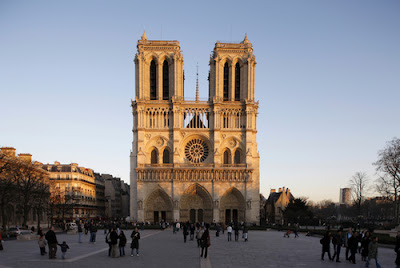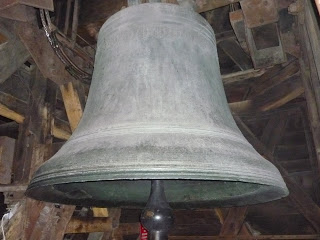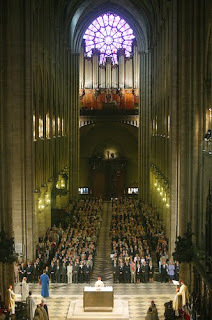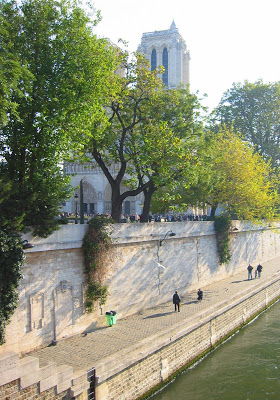NINE NEW BELLS TO BE INSTALLED IN NOTRE-DAME DE PARIS: WHAT WOULD QUASIMODO SAY?
These four bells were cast in 1856, per the request of Napoleon III who wanted them to mark the occasion of his son’s baptism, and have rung every 15 minutes since then.
As part of a $3.5 million project (that will also renovate the cathedral’s vast lighting system and famous organ), the bells will be silenced. They will be replaced by nine new bells that will be cast in the same weight and size as the original 17th century bells. Remarkably, they will be designed to create the same sound as those 17th century bells. According to the New York Times (October 18, 2011), the sound will have “a deeper resonance and a lower tone than [that heard] today.”
 |
| Our dog Pal visits Notre-Dame in 2002 |
The latter group argues that bells, cast of low-quality metal, are now worn out and out of tune; replacing them with new bells will…
provide a more authentic and harmonious sound than that heard today. Click here to hear a sample of what new bells will sound like (from the Notre-Dame web site).
A little history might put some of this controversy in perspective. Up until the revolution, Notre-Dame had twenty bells. As best I can gather, eight major bells were in the North Tower; two great bells were in the South Tower; seven in the spire; and three that chimed for the clock. During the Revolution in 1789, all of the cathedral’s bells and many other religious symbols were taken by the revolutionaries—as was the case throughout France. All but one of the bells were melted down to produce cannons and coins.
 |
| North and South towers of Notre Dame Photo: NDP |
 |
| Bourdon Emmanuel Photo: Freedom Wizard |
In 1856, the four bells mentioned above were installed and, later in that century, six small bells were cast and installed in and around the spire, making a total of eleven bells still there today.
 |
| Notre-Dame interior Photo: NDP |
I think Victor Hugo’s Hunchbacked Quasimodo, who sacrificed his hearing to ring the bells of Notre-Dame, intimately appreciated the importance of a harmonious sound and would approve….although he might not so readily embrace the idea of the software program that now controls his beloved bells.
 |
|
Quai du Marché Neuf
|

It is funny, but wherever Mark and I go, we end up recording the sound of the church bells at festivals and holy days. Bell ringing moments are often those we remember most vividly from our travels: the noontime bells in asan Gimignano that sent the swallows from the towers and into the sky to dance – the incredibly spiritual feeling we had when the bells of St. Anne de Beaupré rang while we walked amongst the Stations of the Cross on the hillside in Québec – sitting in the gardens at the National Cathedral in DC and hearing the change-ringing – the bells of the Duomo in Arezzo sending a blessing to the jousters about to spar.
I am thrilled that Notre Dame will be getting her new bells – it's high time!
My iPad didn't allow me to proof and change things – that was to have been San Gimignano! Also, I wanted to say that a trip to hear the new bells would be a fun adventure, eh?
~ David
Hi David,
We, too, attend to the bells and often feel quite moved by them. I gather that you fall into the camp that supports replacing the discordant bells with bells that will ring out with a more authentic sound….me, too! And, yes, it would be so much fun to be there when they are "unveiled." We were there when the euro was introduced, why not the Notre-Dame bells?–they will undoubtedly be around a lot longer than the euro!
My best,
Susan
why nine new bells?, not necessary. 9 new bells should be when notre dame turns 900 years old!
from Janine, in cloudy Florida
Hi Janine,
Good idea! Maybe 50 more years is just too much cacophony to bear!
Amitiés,
Susan, in sunny (and now vacant!) New Hampshire
Can't tell you how much I love your blog..the variety is amazing, always something interesting. Well done…Jan Sommer
Thanks, Jan! I so enjoy hearing about your European adventures! My best, Susan
That beagle is so cute!